Iloilo is located in the Western Visayas Province. Its capital is Iloilo City. It is known for its century-old churches, yummy bowl of Lapaz Batchoy and Pansit Molo, Dinagyang Festival, and their soft-sweet tone Ilonggo dialect.

getting ready for landing at Iloilo International Airport
When my hubby and his team had a provincial project in Iloilo he enjoined me to go there for a weekend getaway. Perfect timing for I will be seeing again “our long time, no see friend” Atty. Flor who decided to pursue her career in her hometown. They already met in the city a few days ago and our friend initially welcomed them with a delectable batchoy treat.
I was so excited in getting to Iloilo, my fifth solo flight so far. My hubby instructed me to ride the affordable Light of Glory taxi at the airport in getting to Amigo Hotel to where they stay. But I took a cheaper ride. I boarded in a shuttle van in getting to SM City Iloilo in Mandurriao for P50 as instructed by an old lady whom I chatted in the airport.
I did not sleep during the ride because I savored every minute watching a laid back scenery. The provincial appeal started as I saw vast plots of rice-fields. I was amused seeing old houses with balusters and some with cherubs on walls. It brought a nostalgia of childhood days to me. I was surprised to see the signage Iloilo Golf and Country Club which was considered the oldest golf course in the Philippines. Travel time: 25 five minutes only.
I ate my lunch at SM City around 2:00 p.m. I explored a bit until I reached the mall’s main entrance.
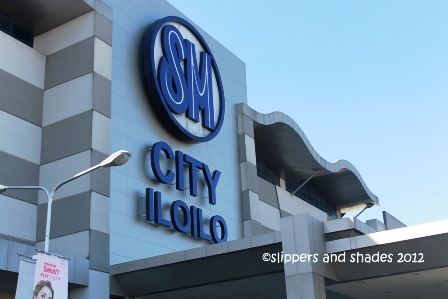
wandering alone at SM City Iloilo
There was a jeepney terminal in front of the mall. I asked the barker where to ride in getting to my destination. He kindly pointed the jeep with SM City Town proper signage. I thanked him and I took a front seat. Fare-P7 (below the minimum fare in Manila) but I paid P15 for two persons sitting comfortably and alone in front. Well, I had a cheap and happy ride!

jeepney terminal in front of SM City Iloilo
It was an exhilarating jeepney trip as I saw a well-developed city. When I saw familiar streets such as Juan Luna and Iznart, I told myself, indeed, “I’m now in Iloilo!”
Flor was waiting in the lobby of Amigo Hotel when I got there. She introduced me to her best-friend Vic and her son, Mat-mat. It was such a delightful feeling seeing a good friend whom I didn’t see for more than a decade. My hubby can’t be with us since he was presently attending in his task. After a short conversation with him through the smartphone, we boarded Vic’s car, and off we went to our exciting escapade.
Iloilo Tour
Our first stop was in the Molo Church in the district of Molo. Its Gothic-Renaissance style was so compelling. The sun was in its full glory and it gave a gleaming glow to the facade. What caught my attention most was the unique red color spires. All churches’ external structures I’ve seen were of the same colors. But this church was an exemption. This was used as a watchtower to warn people from attackers during World War II.
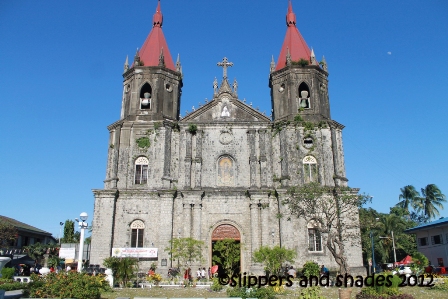
we visited first Molo Church
Molo Plaza is facing Molo Church. Its classical effect brought me back to my Greek Mythology subject in college when I saw the gazebo, which is the main attraction in the plaza. It has six goddesses standing at the pedestal. So relaxing to see trees everywhere, some had gnarled branches and some were old. So good to walk or stroll in the smooth pathway. It wasn’t crowded at that time because it was still stifling hot. What I enjoyed most is seeing people and their culture. Though I didn’t understand their dialect, it’s a rewarding experience dealing with them.
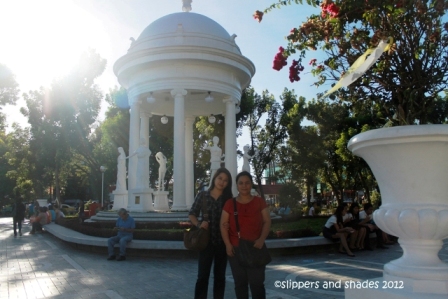
me and Flor near the gazebo of Molo Plaza
According to my friend, this is the most beautiful plaza in the city especially during the Christmas season where the trees are glistening with adorned Christmas lanterns.
We bought yummy crispy cookies in Mama’s Kitchen in Arevalo. It wasn’t a typical bakery or store that could be seen along the main road. It was a well-preserved two-story ancestral house where cookies and products from the fiber of Sinamay which is known as abaca are found.
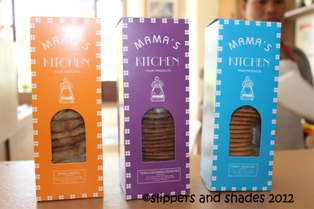
different flavors to choose from
Inside, I was brought back in the past as I saw the blue vintage car and an old weaving machine. After a short tour, we bought four cookies with bits of pinipig, tsokolate, cashew, and mango. Mango was the best for me. I can’t help to munch it as we went back to the car.
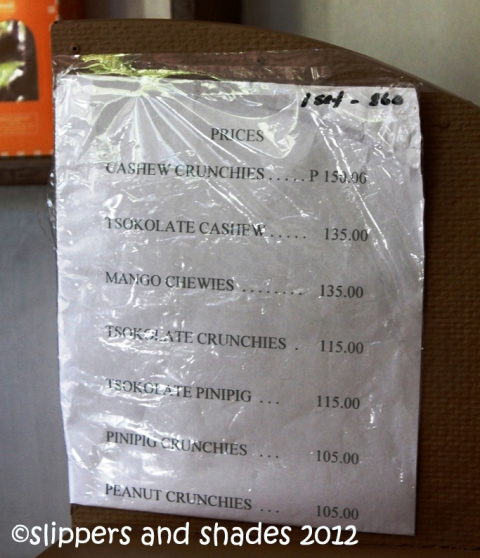
price list of cookies
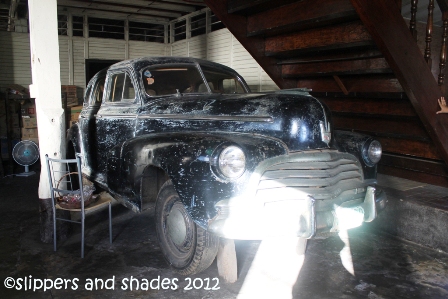
the blue vintage car
We bought mineral water in Panaderia de Iloilo in Osmena Street, Arevalo, the first bakery in Iloilo which was in circulation since the late sixties. It sells traditional Ilonggo bread, biscuits, and pastry products. It serves yummy foods at an affordable price.
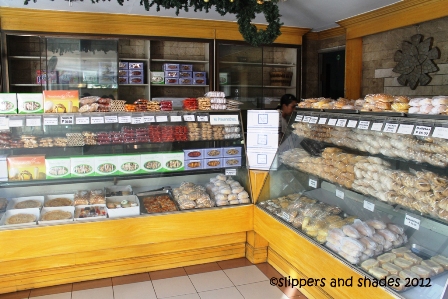
yummy goodies of Panaderia de Iloilo
From Arevalo, we headed to Tigbauan, Guimbal, and Miag-ao towns to where its local points of interest are their century-old churches.
Tigbauan Church was inspired by Latin American churrigueresque architecture. It has a beautiful stone carving on the facade facing the plaza. Looking from the top, one will see the two bell towers, the arched windows, the statues of Sto. Nino and San Nicholas de Tolentino. Below is the bas-relief of the heart arrow with flowers and cords. The focus is the head of the cherub which was dramatically set at the capstone of the main entrance.
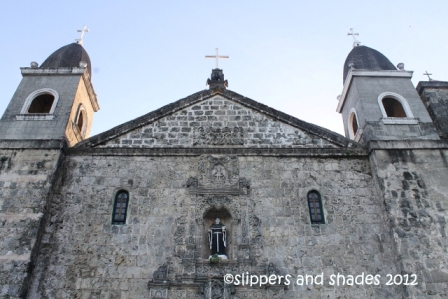
the simple Tigbauan Church
The design of this church was so simple. But when we went inside, what amused me so much was the colorful mosaic on the interior walls of the church. But it was a snap visit only as respect to the people doing their solemn activity inside. We went to the grassy lot with small monoliths aligned in one corner. We got curious looking in an old deep well with no hand pump. Nothing much to see, we headed to the next town.
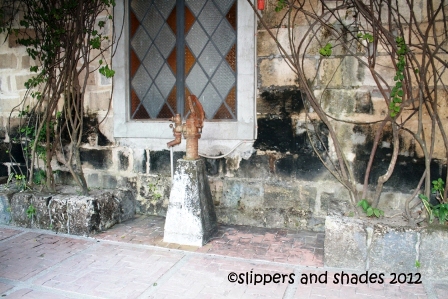
the old deep well
Guimbal Church is just across the plaza and the Municipal Building. The plaza had a nice landscape of ornamental flowers, plants, and trees with concrete benches and the monument of Dr. Jose Rizal which was painted all in white. I was told that this was the church of San Nicolas de Tolentino and one of the oldest churches in the country.
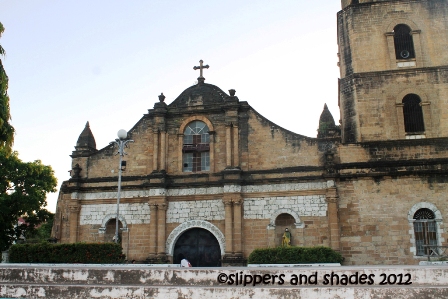
the yellowish Guimbal Church
It survived from the damages of World War II and from an earthquake where a meticulous reconstruction to revive its original structure was done. Its yellowish color is made of adobe stones called “igang” and coral stones. I didn’t chance to see its interior design because it was closed that day.
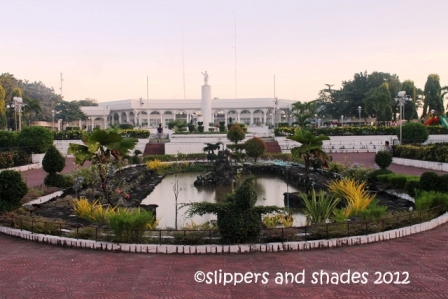
a lovely park and a municipal hall facing Guimbal Church
Miag-ao Church is also known as the church of Sto. Tomas de Villanueva and is included in the UNESCO World Heritage list. I was impressed by the architectural idea behind its construction. The facade which was warm-yellow in color has unique carvings of various reliefs and ornaments. The facade was supported by two different belfries, the four-storey bell tower and the tree-storey tower which looked like a medieval castle. The side structure looked like a fortress, almost resembled Intramuros of Manila.
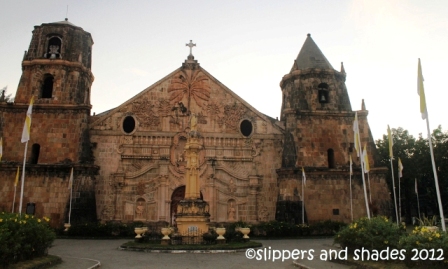
the stunning and impressive Miag-ao Church
There were students sitting on the grass, some were singing and some were just hanging around. Of all the churches I’ve visited, the last was the most stunning. Now I know why this was considered as a world-renowned religious structure.
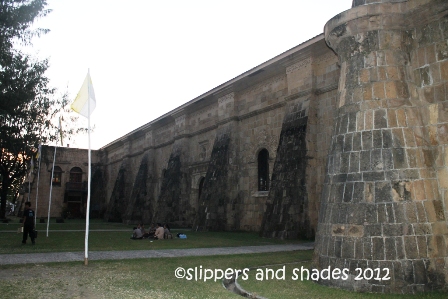
looked like a fortress almost resembled to Intramuros
Thank you Flor for bringing me back to Philippine history. I love this subject during my high school days. It’s quite amusing that Iloilo had preserved these architectural treasures.
We were allowed by the security guard to visit the spacious University of the Philippines-Visayas campus. We didn’t hop out of the car because it was getting dark. We passed by the standing oblation, buildings, and young ladies having their evening walk while others were on a jog.
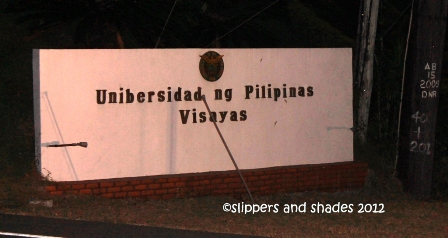
getting inside the campus
We met my hubby and his team, Jay and Bim for a yummy dinner at Tatoy’s Restaurant situated in Villa at 7 p.m. Flor told me that Tatoy’s specialty is their fried native Lechon chicken. Indeed, it was a yummy chicken! It was my first time eating talaba (oyster) which costs P40 per kilo. Other yummy cuisines were boneless bangus, sinigang na hipon (boiled shrimp), lechon, and the fresh lato.
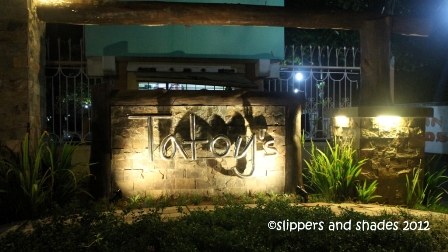
the entrance at Tatoy’s Restaurant
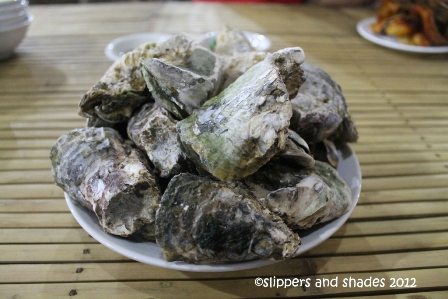
my first time to eat talaba (oyster)… it was good

yummy native chicken, Tatoy’s specialty food
What a delectable dinner we had! Again, thank you Flor for the treat, for the learning and for the wonderful time spent with us.
The next day, Guimaras Tour!

